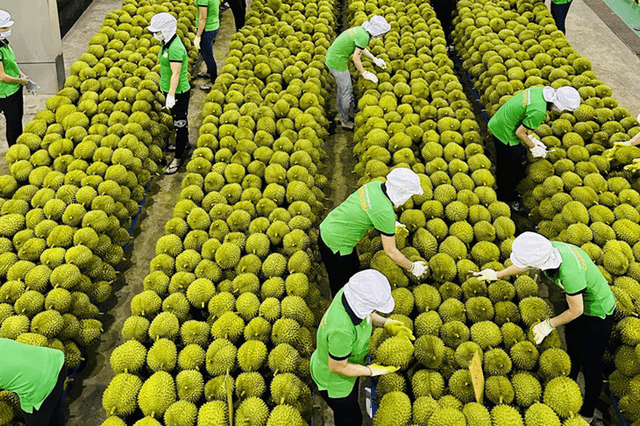In contrast to the first months of 2022 when many markets were almost frozen because of the COVID-19 pandemic, in the last months of the year, the vegetable industry saw strong growth from many new markets.
Fruit and vegetable exports exceeded 3 billion USD
Vegetables and fruits have been mainly exported to China, but because of the “Zero Covid” policy, until July 2022, the fruit and vegetable industry only recorded negative export value compared with the same period in 2021. According to the General Department of Customs, in the first 6 months of the year, exports of these items decreased by 17.3% with a turnover of 1.7 billion USD.

Durians are cleaned for packaging. (Photo: Internet)
The fruit and vegetable industry started to record positive growth in August 2022 with an impressive result, up to 19.7% over the same period in 2021. In the following months, exports of these items continued to grow positively. As a result, by the end of 2022, fruit and vegetable exports exceeded 3 billion USD, reaching 3.365 billion USD, only down 5.1% compared with 2021.
With a sharp decrease in exports to China, the fruit and vegetable industry has proved its durability when the pandemic becomes less stressful and has grown strongly in many other markets such as the US (up 14.4% in 11 months 2022), Korea (up 14.1%), Thailand (up 19.7%), Japan (up 7.3%), the Netherlands (up 47.2%), and Australia (up 5.5%).
The vegetable and fruit is one of the few negative growth sectors compared with 2021 of the agricultural industry. However, this sector still receives a lot of good news from the opening of the market for many key fruits.
The Department of Crop Production (MARD) said that in 2022, the area of fruit trees reached 1.21 million ha, up 41,300 ha; the output was about 18.68 million tonnes. The output and quality of most key fruit trees with advantages of the whole country and each region increased, such as mango 1.022 million tonnes, up 2.25%; dragon fruit over 1.197 million tonnes, down 13.7%; grapefruit 1.1 million tonnes, up 6.73%; lychee 376,000 tonnes, up 1.2%; durian 836,300 tonnes, up 24.1%; pineapple over 738,000 tonnes, up 1.65%; and banana 2.48 million tonnes, up 5.5%.
Plenty of potentials in 2023
In 2022, China has opened its official quota for Vietnamese durian. Immediately after the official opening, Vietnam’s durian exports to China came in second place in terms of export value among Vietnam’s fruit export group.
Especially in October 2022 alone, the value of durian exports to China reached nearly 50 million USD, up more than 4,000% over the same period last year. Thus, in the first 10 months of 2022, durian exports to China increased by 91.5% over the same period in 2021. China also issued 37 more growing area codes and durian packaging facilities for Vietnam in the last months of the year.

Potentials of Vegetable and Fruit Exports are expanding in 2023. (Photo: Internet)
Also in 2022, China opened the official quota for Vietnamese sweet potatoes; Vietnamese grapefruit was licensed for export to the US; Japan opened the door for Vietnamese longan; Vietnamese limes were exported to New Zealand, etc. These are favorable conditions to promote Vietnam’s fruit and vegetable exports in the coming years.
At the Conference of review 2022 and implementing the tasks in 2023 of Agriculture and Rural Development industry on January 13, Deputy Minister of Industry and Trade Nguyen Sinh Nhat Tan said that: to promote exports, the agricultural sector needs to focus on restructuring production to raise the value of Vietnamese agricultural products; develop policies to promote border trade, changing to official quota; accelerate negotiations with foreign partners to increase the number of agricultural, forestry, and fishery products exported to markets, especially China.
At the same time, Deputy Minister Nguyen Sinh Nhat Tan also suggested MARD focus on trade promotion programs, especially on digital platforms, e-commerce, and application of information technology to promote exports and consumption of agricultural products; effectively implement trade defense, solve disputes and lawsuits in international trade, and create favorable conditions for agricultural export enterprises.
Mr. Le Thanh Hoa, Deputy Director of the Department of Agricultural Product Processing and Market Development (MARD), said that domestic demand and year-end exports for fruits were quite large.
Currently, exports must be associated with growing areas and packaging facilities. Each growing area is also attached to output and area. If it is improperly done, exports will be greatly affected. Along with that, the sharp change to official exports for China will contribute to promoting positive growth in the fruit and vegetable industry.
Mr. Le Thanh Hoa emphasized: “The global processed fruit and vegetable market is forecast to reach about 392 billion USD by 2025. Currently, Vietnam exports mainly in the form of fresh fruit, and it is difficult to transport over a long distance due to the inability to preserve for a long time. Therefore, the MARD is looking forward to the fruit and vegetable industry focusing on the processed product segment because this is the trend of the market in the coming time. In particular, in the current context, businesses need to maintain the market and always ensure food quality and safety, because this is the vital factor for us to keep the market.”/.
